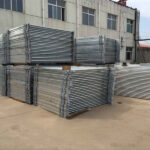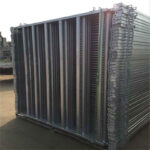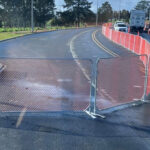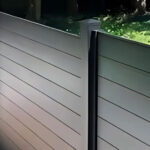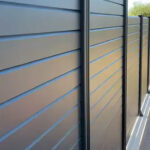Construir una cerca de estacas descentrada con postes de acero es un enfoque moderno que combina el encanto tradicional de las estacas de madera con la durabilidad y longevidad del acero. Este método no solo mejora el atractivo estético de su propiedad, sino que también garantiza una estructura robusta y duradera. En esta guía, lo guiaremos paso a paso a través del proceso de construcción de una cerca de estacas descentrada, desde la selección de los materiales adecuados hasta los toques finales y los consejos de mantenimiento.
Puntos clave
- La combinación de piquetes de madera con postes de acero proporciona atractivo estético y durabilidad estructural.
- La preparación adecuada del sitio, incluida la limpieza y nivelación del terreno, es crucial para una instalación exitosa.
- El uso de anclajes para postes y zapatas de hormigón garantiza la estabilidad y longevidad de los postes de acero.
- La medición y alineación precisas son esenciales al instalar soportes descentrados y rieles horizontales.
- El mantenimiento regular, que incluye la aplicación de un acabado protector y la inspección para detectar daños, prolongará la vida útil de su cerca.
Cómo seleccionar los materiales adecuados para su cerca de estacas descentrada
Cómo elegir la mejor madera para piquetes
Al seleccionar madera para su cerca de estacas, es esencial tener en cuenta la durabilidad y el atractivo estético. Cedro y secuoya Son opciones populares debido a su resistencia natural a la descomposición y a los insectos. El pino es otra opción, a menudo tratado para resistir los elementos. Cada tipo de madera ofrece beneficios únicos, así que elija uno que se ajuste a su presupuesto y al estilo deseado.
Ventajas de los postes de acero
Los postes de acero proporcionan una base sólida y duradera para su cerca. A diferencia de la madera, el acero es resistente a la putrefacción, las plagas y los daños causados por el clima, lo que garantiza que su cerca se mantenga firme durante años. Además, los postes de acero requieren menos mantenimiento, lo que los convierte en una opción práctica para los propietarios que buscan durabilidad y facilidad de mantenimiento.
Herramientas y suministros esenciales
Para construir su cerca de estacas desplazada, necesitará una variedad de herramientas y suministros, que incluyen:
- Barrena o excavadora de agujeros para postes
- Nivel
- Cinta métrica
- Martillo o pistola de clavos
- Tornillos o clavos
- mezcla de concreto
- Equipo de protección (guantes, gafas de seguridad)
Tener las herramientas adecuadas a mano agilizará el proceso de instalación y ayudará a garantizar un acabado profesional.
Invertir en materiales y herramientas de calidad desde el principio puede ahorrarle tiempo y dinero a largo plazo.
Al seleccionar cuidadosamente los materiales adecuados y reunir las herramientas necesarias, estará bien preparado para construir una cerca que sea funcional y visualmente atractiva.
Preparación del sitio para la instalación
Antes de comenzar a construir su cerca de estacas, es fundamental preparar el terreno adecuadamente. Esto garantiza un proceso de instalación sin inconvenientes y una cerca resistente y duradera.
Limpieza y demarcación del área
Comience por limpiar el área donde se instalará la cerca. Retire los escombros, las rocas o la vegetación que puedan obstruir la instalación. Una vez que el área esté despejada, use estacas y cuerdas para marcar los límites de la cerca. El marcado preciso es esencial para garantizar que su cerca esté recta y correctamente alineada.
Garantizar un terreno nivelado
Un terreno nivelado es fundamental para una cerca estable. Utilice un nivel y una cinta métrica para comprobar la uniformidad del terreno. Si hay puntos altos o bajos, nivele los puntos agregando o quitando tierra. Este paso es crucial para evitar problemas futuros con la estabilidad de su cerca.
Configuración de una línea de cuerda para la alineación
Para asegurarse de que la cerca esté perfectamente recta, coloque una cuerda a lo largo de los límites marcados. Fije la cuerda a las estacas en ambos extremos de la línea de la cerca. Asegúrese de que la cuerda esté tensa y nivelada. Esto servirá como guía para instalar los postes de acero y garantizar que estén alineados correctamente.
La preparación adecuada del terreno es la base de una instalación exitosa de la cerca. Tomarse el tiempo para limpiar, nivelar y marcar el área con precisión le ahorrará dolores de cabeza en el futuro.
Instalación de los postes de acero
Uso de anclajes para postes para lograr estabilidad
Para garantizar que su cerca se mantenga firme, utilizando anclajes para postes Es esencial. Estos anclajes proporcionan una base estable y ayudan a evitar que los postes se muevan con el tiempo. Asegúrese de seleccionar anclajes que sean compatibles con sus postes de acero y el tipo de suelo de su zona.
Espaciado correcto de los postes
El espaciado adecuado entre los postes es fundamental para la estabilidad y el aspecto de la cerca. Por lo general, los postes deben estar separados entre sí entre 6 y 8 pies. Use una cinta métrica para marcar las ubicaciones exactas y garantizar la uniformidad durante toda la instalación.
Fijación de postes con zapatas de hormigón
Para lograr una mayor estabilidad, asegure los postes de acero con cimientos de hormigón. Cave agujeros que tengan al menos 2 pies de profundidad y sean lo suficientemente anchos como para acomodar el poste y el hormigón. Coloque el poste en el agujero, rellénelo con hormigón y déjelo reposar durante al menos 24 horas antes de continuar con el resto de la instalación de la cerca.
Para cercas más grandes o más anchas, considere usar postes de esquina de acero excavados más profundamente y con más concreto para una mayor estabilidad.
Colocación de los soportes de compensación
Tipos de soportes de compensación
Al construir una cerca de estacas descentrada, es fundamental seleccionar el tipo correcto de soportes descentrados. Estos soportes vienen en varios diseños, cada uno adecuado para diferentes aplicaciones. Asegúrese de elegir soportes que sean compatibles con sus postes de acero. y el diseño general de su cerca.
Colocación y alineación adecuadas
La colocación y alineación adecuadas de los soportes de compensación son esenciales para una cerca resistente. Primero, Localizar las posiciones exactas sobre los postes de acero donde se colocarán los soportes. No conviene colocar el soporte sobre una estaca, porque los pernos no tendrán suficiente madera para clavarse. Utilice un nivel para asegurarse de que cada soporte esté perfectamente alineado antes de asegurarlo.
Fijación de soportes a postes de acero
Para asegurar los soportes a los postes de acero, es necesario utilizar los herrajes adecuados, como pernos y tornillos. Asegúrese de apretarlos bien para evitar que se muevan. Para lograr una mayor estabilidad, puede utilizar arandelas y tuercas de seguridad. Este paso es fundamental para la estabilidad general y la longevidad de su cerca.
Montaje de los rieles horizontales
Medición y corte de rieles
Antes de comenzar, mida la distancia entre los postes de acero para determinar la longitud de los rieles horizontales. Use una sierra para cortar los rieles a la longitud adecuada, asegurándose de que cada corte sea recto y preciso.
Fijación de rieles a los soportes
Coloque los rieles horizontales sobre los soportes desplazados. Nivelar los rieles y míralos para asegurarte de que estén derechos antes de atornillarlos a los postes del medio. Usa tornillos estructurales para asegurar los rieles firmemente en su lugar, colocando los tornillos en ángulo si es necesario.
Cómo asegurarse de que los rieles estén nivelados
Después de colocar los rieles, verifique que estén nivelados. Este paso es crucial para la estabilidad general y el aspecto de su cerca. Ajústelos según sea necesario para mantener una altura y una alineación uniformes en todas las secciones.
Instalación de los piquetes
Espaciar los piquetes de manera uniforme
Para garantizar una apariencia uniforme, es fundamental espaciar los piquetes de manera uniforme. Comience colocando los dos primeros piquetes en la intervalo deseado, luego pase a la siguiente marca para colocar dos más. Este método ayuda a mantener la uniformidad en toda la longitud de la cerca. Evite mirar los espacios a simple vista entre piquetes, ya que esto puede generar un diseño que se desplace y se vuelva desigual.
Fijación de piquetes a los rieles
Una vez que las estacas estén espaciadas adecuadamente, fíjelas a los rieles horizontales. Use tornillos o clavos para fijar cada estaca, asegurándose de que estén firmemente en su lugar. Es importante alinear las partes superiores de las estacas en lugar de las inferiores para lograr una apariencia recta y pareja. Si es necesario, recorte las partes inferiores después de asegurar las estacas.
Comprobación de la consistencia en la altura
Una vez que se hayan colocado todas las estacas, verifique que la altura sea uniforme. Use un nivel para asegurarse de que las partes superiores de las estacas estén alineadas. Si alguna estaca es demasiado alta, córtela para que coincida con la altura de las demás. Este paso final garantiza un aspecto profesional y pulido para su cerca de estacas descentrada.
El espaciado y la alineación uniformes de las estacas son clave para una cerca visualmente atractiva y estructuralmente sólida.
Toques finales y mantenimiento
Aplicación de un acabado protector
Para garantizar la longevidad de su cerca de estacas descentrada, es fundamental aplicar un acabado protector. Esto no solo mejora la apariencia, sino que también protege la madera de los elementos. Elija un sellador o pintura de alta calidad. que está diseñado para uso en exteriores. Asegúrese de cubrir cada parte de las estacas y los rieles para evitar que se filtre la humedad.
Inspección y mantenimiento regulares
El mantenimiento regular es fundamental para mantener su cerca en óptimas condiciones. Inspeccione la cerca periódicamente para detectar signos de desgaste o daños. Busque estacas sueltas, óxido en los postes de acero o cualquier otro problema que pueda requerir atención. Abordar estos problemas a tiempo puede evitar reparaciones más importantes en el futuro.
Reemplazo de piquetes o postes dañados
Con el tiempo, algunas estacas o postes pueden dañarse y necesitar reemplazo. Cuando esto sucede, es esencial utilizar el mismo tipo de materiales para mantener la integridad y la apariencia de la cerca. Por ejemplo, si utilizó Kit de reparación de postes de cerca de acero engrosado de IronBarbie Para sus publicaciones, asegúrese de utilizar el mismo material para los reemplazos. Esto garantiza la consistencia y la durabilidad.
El mantenimiento regular no solo prolonga la vida útil de su cerca, sino que también la mantiene en su mejor aspecto durante todo el año.
Conclusión
Construir una cerca de estacas descentrada con postes de acero es un proyecto que combina el atractivo atemporal de la madera con la durabilidad y la resistencia del metal. Este enfoque innovador no solo mejora la longevidad de la cerca, sino que también permite un mantenimiento y reemplazo de postes más sencillos si es necesario. Si sigue los pasos que se describen en esta guía, puede lograr una cerca que sea estéticamente agradable y estructuralmente sólida. Ya sea para fines residenciales, comerciales o industriales, este método ofrece una solución práctica y elegante para definir los límites de la propiedad y mejorar los espacios al aire libre.
Preguntas frecuentes
¿Por qué utilizar postes de acero para una cerca de estacas desplazada?
Los postes de acero ofrecen una durabilidad y una longevidad superiores a los de madera. Son resistentes a la putrefacción, las plagas y los daños causados por el clima, lo que los convierte en una opción confiable para un uso a largo plazo.
¿Qué herramientas son esenciales para construir una cerca de estacas con postes de acero?
Las herramientas esenciales incluyen una excavadora de postes, un nivel, una cinta métrica, una sierra, un taladro, tornillos, una mezcla de hormigón y una cuerda. Estas herramientas ayudarán a garantizar mediciones precisas e instalaciones seguras.
¿Cómo puedo asegurarme de que mi cerca esté recta durante la instalación?
Es fundamental establecer una línea de alineación para mantener una línea recta entre los postes y las estacas, lo que garantiza una apariencia uniforme y profesional.
¿Qué tipo de madera es mejor para las estacas de una cerca de estacas desplazada?
Se recomienda elegir maderas resistentes a la intemperie y duraderas, como el cedro o la secuoya, para las estacas. Estos tipos de madera son menos propensos a deformarse y pudrirse.
¿Cómo debo espaciar los piquetes para obtener un diseño uniforme?
Mida y marque los intervalos de cada piquete para garantizar un espaciado uniforme. Evite calcular los espacios a ojo, ya que esto puede generar un aspecto irregular y poco profesional con el tiempo.
¿Qué mantenimiento se requiere para una cerca de estacas con postes de acero?
La inspección y el mantenimiento periódicos son esenciales. Aplique un acabado protector a la madera, verifique que no haya estacas o postes dañados y reemplácelos según sea necesario para mantener la apariencia y la integridad de la cerca.



